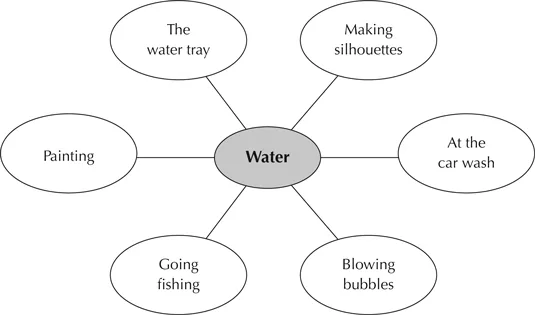![]()
Water offers numerous opportunities across all areas of learning. Children have a natural fascination with water and it can provide some of the most exciting and exhilarating types of play. All children have some experience of water in their lives whether it’s through swimming, visits to the beach, washing up, drinking, bath time, rain or splashing in puddles. It is in fact one of the only resources in the setting that every child will undoubtedly have had some experience of. They will already have created their own ideas about capacity and will enjoy exploring these ideas further when working in the water tray, using buckets of water in the outdoor area or squirty bottles and hoses. The language that children will use in this area of provision will be rich and varied when modelled and supported by adults.
Links to Other Areas of Learning
Personal Social and Emotional Development | - Developing independence by choosing and using a range of tools and equipment
- Developing self-care by putting on wellies and coats for outdoor use
- Working as a group, negotiating plans and the use of equipment
- Opportunities for sustained play for long periods of time, particularly in the outdoor area
|
| | |
Communication and Language | - Water words such as drip, splash, drop, splosh
- Imaginative play involving themes such as underwater adventures, bath time and seaside
- Talking about ideas and plans when using water and negotiating with others about resources and equipment to use
|
| | |
Literacy | - Stories and rhymes about water
- Using water pots with brushes to write letters and words in the outdoor area or on large paper
|
| | |
Understanding the World | - Investigating water and its properties using all the senses
- Finding out about weather and the impact it has on the local area or wider world
- The importance of water for growing plants, fruit and vegetables; investigating the effect on plants if they have no water, for example using cress, beans or sunflowers
- Exploring floating and sinking on large and small scales; linking this to boats and travelling on water
- Investigating forces, for example ways of moving water using water wheels or pipettes
- Identifying the uses of water in our world, for example for washing and cleaning, and including religious links such as baptism
- Religious stories from the Bible such as Noah’s Ark
|
| | |
Physical Development | - Using a range of tools and equipment when exploring water in the water tray or outdoor area
- Talking about the role of water to keep us healthy, including drinking water, cleaning teeth and hand washing
- Developing fine motor skills by using equipment such as pipettes or brushes with water
|
| | |
Expressive Arts and Design | - Songs and rhymes linked to water
- Small world play contexts linked to water such as the seaside or underwater
- Painting with water or using watercolour paints on different types of paper
- Mixing colours in puddles or in the water tray using food colouring
- Rain sounds and water sounds using instruments such as shakers, rain sticks and tambourines
|
| | |
Mathematics | - Capacity
- Shape
- Number
- Counting
- Calculating
|
- Empty bottles and containers
- Buckets
- Funnels
- Tubes
- Guttering
- Pipes
- Pipettes and syringes for sucking up water and squirting
- Pots with holes
- Measuring cylinders, jugs and spoons
- Water wheels
- Bubbles
- Various sized brushes
- Cups
- Wellington boots and rain-proof clothing
- Sponges and cloths
- Food colouring
- Nets
Making Silhouettes
Explain that the water tray resources keep getting mixed up. Can the children think of a way of organising them? Allow time to explore sorting the equipment and note children’s choices. What is the same about each piece of equipment? What is different? Can the children make a record of the equipment that is in the water tray? Talk about how they can use this to check whether any items are missing or if the correct number of items are in the tray. Work with the children to create a silhouette plan of each piece of equipment by drawing around the base of each. Can the children match each container or resource to its silhouette image? When the plan is being made talk about organising the equipment into the order of containers that hold the least to those that hold the most water.
At the Car Wash
Explain that the cars and bikes in the outdoor area are very dirty and need to be cleaned. Ask the children to help. Talk to them about what they will need, for example buckets, sponges, water and hoses. Discuss the idea of not wasting water so they need to be careful how much they use. How much water do they think it will take to wash one car? Two cars? How many cars could they wash with 5 buckets of water? Test out their ideas. Provide a range of differently sized buckets and explore their ideas about which holds more or less by using them to wash small cars or bikes. How many small buckets of water are needed? Is this more or less than the number of tall buckets/wide buckets? Encourage children to label the cars with how many buckets of water were needed to wash them using chalks on the floor in the outdoor area.
Blowing Bubbles
Work with children to make a bubble mixture by mixing washing up liquid with water. Use small bubble wands from bubble bottles to practise blowing bubbles. Can they describe the bubbles that they blow using mathematical language to identify their size and shape? Set challenges for children with bottles of bubbles, such as who can blow 10 bubbles exactly? Who can blow the biggest/smallest bubble? Who can blow bubbles to travel over the wall? Once children have explored bottles of bubbles, talk about how to make different-shaped bubbles using new wands. Use thin wire with the children to make new shapes such as triangles and squares for larger bubble wands. Put these wands into the bubble mixture to coat the wand and then wave them through the air. What shape are the bubbles? Are all the bubbles the same or are they different?
Going Fishing
Place a range of different-coloured objects in the water tray. Provide children with a variety of coloured buckets (matching the colours of the objects). Explain that the children are going fishing. Give them a range of different-sized nets and allow them to have time to fish for the objects; note whether they choose to sort the objects using the coloured buckets. Prompt children to sort the objects by colour, using the buckets if they do not choose to after time exploring. Pose questions to extend children’s learning, such as, can they find out how many of each colour object there are? Can they record this to label each coloured bucket? Which colour has the most/least objects? If there was one more red/yellow object how many would there be? How many red and yellow objects are there altogether?
Painting
Use chalks with the children to draw shapes or write numerals in the outside area. Give each child an empty paint pot and ask each to fill the pot, for example ‘half full’, ‘nearly full’ or ‘full’. Can they fill the pots correctly? Provide each child with a paint brush and allow time to make marks using the brushes, matching the shapes and numbers made with chalks. Can they wash the chalk shapes or numerals away by tracing over them using the water? Who can draw...






